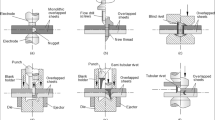Abstract
This paper presents a new joining by forming process capable of attaching a sheet to the end of a tube without the need of accessories and extra materials. The process is named as ‘self-pierce riveting of tubes to sheets’ and is an extension to sheet-tube connections of the working principle of double-sided self-pierce riveting utilized for connecting two overlapped sheets. The process requires tubes with chamfered ends to be pushed against the sheets and its ends to flare (curl) in order to create an interlocking that holds the sheets and tubes tightly together. The resulting joints are invisible because the interlockings are hidden inside the sheets. The presentation draws from deformation mechanics and identification of the major parameters to characterization of the interlocking and evaluation of the pull-out destructive strength that the new joints are capable to withstand without failure. Aluminium sheets and carbon steel tubes are utilized to demonstrate the effectiveness of the new joining by forming process and to demonstrate its ability to connect sheets and tubes made from dissimilar materials at room temperature. Finite element modelling using an in-house computer program gives support to the presentation.










Similar content being viewed by others
Availability of data and material
The authors confirm that the data and material supporting the findings of this work are available within the article.
References
Kato K, Okamoto M, Yasuhara T (2001) Method of joining sheets by using new type of rivets. J Mater Process Technol 111:198–203
Huang Z, Xue S, Lai J, Xia L, Zhan J (2014) Self-piercing riveting with inner flange pipe rivet. Procedia Eng 81:2042–2047
Huang Z, Yao Q, Lai J, Zhao J, Jiang Z (2017) Developing a self-piercing riveting with flange pipe rivet joining aluminum sheets. Int J Adv Manuf Technol 91:2315–2328
Alves LM, Afonso RM, Martins PAF (2020) Double-sided self-pierce riveting. Int J Adv Manuf Technol 108:1541–1549
Li D, Chrysanthou A, Patel I, Williams G (2017) Self-piercing riveting - a review. Int J Adv Manuf Technol 92:1777–1824
Ma H, Yu HJ, Qian CF, Liu ZS, Zhou JX (2015) Experimental study of hydraulically expanded tube-to-tubesheet joints for shell and tube heat exchangers. Procedia Eng 130:263–274
Alves LM, Martins PAF (2013) Single-stroke mechanical joining of sheet panels to tubular profiles. J Manuf Process 15:151–157
Alves LM, Afonso RM, Silva CMA, Martins PAF (2018) Joining tubes to sheets by boss forming and upsetting. J Mater Process Technol 252:773–781
Nielsen CV, Zhang W, Alves LM, Bay N, Martins PAF (2013) Coupled finite element flow formulation in: modelling of thermo-electro-mechanical manufacturing processes with applications in metal forming and resistance welding, Springer-Verlag, London, UK. https://doi.org/10.1007/978-1-4471-4643-8_3
Ugural AC (1960) Stresses in Plates and Shells. McGraw-Hill, New York, USA
Acknowledgements
The authors would like to acknowledge the support provided by Fundação para a Ciência e a Tecnologia of Portugal and IDMEC under LAETA-UIDB/50022/2020. Luis Alves would also like to thank the support provided by provided by Fundação para a Ciência e a Tecnologia of Portugal under SFRH/BSAB/150323/2019.
Funding
This work was supported by Fundação para a Ciência e a Tecnologia of Portugal and IDMEC under LAETA-UIDB/50022/2020 and Fundação para a Ciência e a Tecnologia of Portugal under SFRH/BSAB/150323/2019.
Author information
Authors and Affiliations
Contributions
Experimentation: Luis M. Alves, Rafael M. Afonso; Numerical modelling: Luis M. Alves, Rafael M. Afonso, Paulo A.F. Martins; Writing (original draft preparation): Paulo A.F. Martins; Writing (review and editing): Luis M. Alves, Rafael M. Afonso, Paulo A.F. Martins; Coordination: Paulo A.F. Martins
Corresponding author
Ethics declarations
Competing interests
The authors have no competing interests or conflicts of interest to declare that are relevant to the contents of this article.
Ethical approval
The article follows the guidelines of the Committee on Publication Ethics (COPE) and involves no studies on human or animal subjects.
Consent to participate
Not applicable. The article involves no studies on humans.
Consent to publish
Not applicable. The article involves no studies on humans.
Additional information
Publisher’s note
Springer Nature remains neutral with regard to jurisdictional claims in published maps and institutional affiliations.
Rights and permissions
About this article
Cite this article
Alves, L.M., Afonso, R.M. & Martins, P.A.F. Self-pierce riveting of tubes to sheets. Int J Adv Manuf Technol 111, 3351–3360 (2020). https://doi.org/10.1007/s00170-020-06347-x
Received:
Accepted:
Published:
Issue Date:
DOI: https://doi.org/10.1007/s00170-020-06347-x




